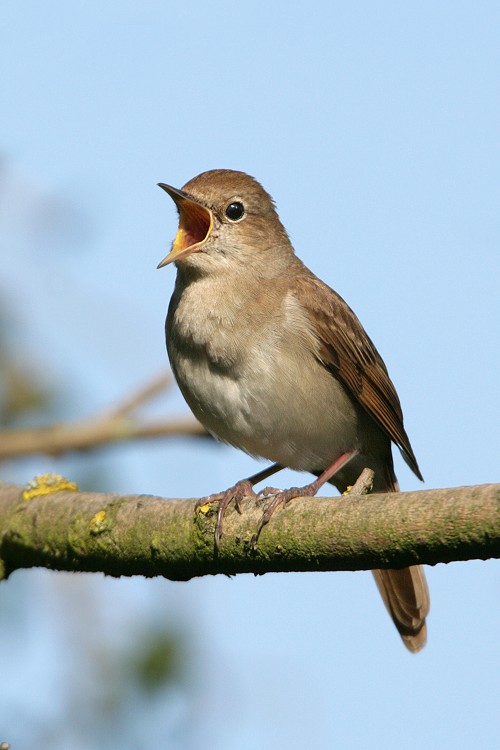- Luscinia megarhynchos
Identification
A grey-brown chat (16 - 17cm), similar to Thrush Nightingale2:
- Warm brown above
- Rusty-brown tail and rump
- Whitish below with sandy-buff breast and flanks
- Prominent large black eye with pale narrow eyering
- Indistinctive grey supercilium
The warm colour and the rusty-red tail are good fieldmarks to distinguish from Thrush Nightingale3. However both species are easily told apart by song.
Distribution
Breeds in southern England and from Iberia and France east to central Poland, Hungary, the Balkans and Greece, also in the Ukraine, Caucasus and northern Turkey, and parts of the Middle East. Breeds on most larger Mediterranean islands and the coastal strip of North-West Africa. First breeding for Malta was in 1995.
Migratory, leaving breeding areas in late July-early October and passing through the southern half of the Region to winter in sub-Saharan Africa and returning from early April-mid May.
Vagrant to Iceland and Ireland, Norway, Sweden and Finland.
Taxonomy
Clements1 accepts three subspecies:
- L. m. megarhynchos found in NW Africa, Europe to C Turkey and the eastern Mediterranean
- L. m. africana found in the Caucasus, E Turkey and to Iran
- L. m. hafizi from E Iran to Kazakhstan, Mongolia, China and Afghanistan
This races differ only slightly in colour and size. They are not always separable.
Like all species of the genus Luscinia it was formerly placed in the thrush Familiy Turdidae.
Habitat
The habitat is varying through the range of this species. In W and N Europe it prefers open woodland with thickets, usually near water. In S Europe also dry maquis, edges of broadleaf forest without water or pinewoods with rich undergrowth are taken.2
Behaviour
Nightingales are named so because they frequently sing at night as well as during the day. The name has been used for well over 1,000 years, being highly recognizable even in its Anglo-Saxon form - 'nihtingale'. It means 'night songstress'. Early writers assumed the female sang, whereas of course it is the male. The male Nightingale is known for his singing, to the extent that human singers are sometimes admiringly referred to as nightingales; the song is loud, with an impressive range of whistles, trills and gurgles. Its song is particularly noticeable at night because few other birds are singing. This is why its name (in several languages) includes "night". Only unpaired males sing regularly at night, and nocturnal song is likely to serve attracting a mate. Singing at dawn, during the hour before sunrise, is assumed to be important to defend the territory. Nightingales sing even more loudly in urban or near-urban environments, in order to overcome the background noise. The most characteristic feature of the song is a loud whistling crescendo, absent from the song of Thrush Nightingale. It has a frog-like alarm call.
Bird Song
<flashmp3>Luscinia megarhynchos (song).mp3</flashmp3>
Listen in an external program
References
Clements, JF. 2008. The Clements Checklist of Birds of the World. 6th ed., with updates to December 2008. Ithaca: Cornell Univ. Press. ISBN 978-0801445019. Spreadsheet available at http://www.birds.cornell.edu/clementschecklist.




